Abstract
Experiments have been conducted to determine the fracture threshold for cast iron and steel when subjected to hydrostatic pressures up to 11300 kg/cm2. General agreement with a maximum elastic strain theory of failure is found.
Résumé
Des expériences ont été effectuées pour déterminer le seuil de rupture des fontes et des aciers soumis à des pressions hydrostatiques jusqu' à 11300 kg/cm2. Une concordance générale avec la théorie de la tension elastique maximum de rupture a été trouvée.
Zusammenfassung
Es wurden Versuche durchgefuehrt zur Bestimmung der Bruchschwelle von Gusseisen and Stahl unter hydrostatischen Drucken his zu 11300 kg/cm2: Allgemeine Uebereinstimmung mit einer Bruchtheorie maximaler elastischer Dehnung wurde gefunden.
Similar content being viewed by others
References
Bridgman, P.W.: “The Effect of Hydrostatic Pressure on the Fracture of Brittle Substances.” J. Appl. Phys., 18, 246 (1947).
Crossland, B.; Dearden, W. H.: “The Plastic Flow and Fracture of a Brittle Material (Grey Cast Iron) with a Particular Reference to the Effect of Fluid Pressure.” Proc. Inst. Mech. Engrs., 172 (26), 805–820 (1958).
Pugh, H.Ll.D.: “tThe Mechanical Properties and Deformation Characteristics of Metals and Alloys Under Pressure.” National Engineering Laboratory Report No. 142, March 1964 (Presented at the International Conference on Materials, organized by the ASTM at Philadelphia, Pennsylvania, February 1964).
Brandes, M.: “Technique of Testing the Strength of Materials Under High Hydrostatic Pressure,” (in Polish). Prace Instytutu Mechaniki Precyzjnej, 10 (4), 1–22 (1962). English translation, NEL 1294, East Kilbride, Glasgow, National Engineering Laboratory.
Timoshenko, S.: “Theory of Plates and Shells,” McGraw Hill Book Company, New YOrk and London, 1940.
Pelczynski, T.: “The Effect of the Stress State on the Transition of Materials in Plastic State.” (in Polish). Przeglad Mechaniczny, No. 6, 7, (1951).
Brandes, M.: “the Effect of High Hydrostatic Pressures on the Cohesive Strength of Brittle Materials,” (in Polish). Prace Instytutu Mechaniki Precyzyjnej, 3, 1–18 (1963).
Woronow, F.F.: Wereshtshagin, F.F.: “The Effect of Hydrostatic Pressure on the Elastic Propertieso of Metals,” (in Russian) Physica Metallow i Metallowiedenije, 11, 3, 443, (1961).
Author information
Authors and Affiliations
Rights and permissions
About this article
Cite this article
Brandes, M. The effect of high hydrostatic pressures on the cohesive strength of brittle materials. Int J Fract 1, 56–63 (1965). https://doi.org/10.1007/BF00184153
Received:
Issue Date:
DOI: https://doi.org/10.1007/BF00184153



